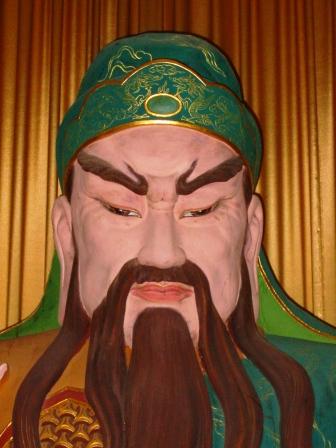guan gong spirit medium
Guan Gong Culture
Guan Gong Culture
Guan Yu (关羽) was a historical person who lived in China during the Three Kingdoms period, (三国) (CE 220-CE 280).
Historical background
Towards the end of the Han dynasty (汉朝), the emperor had been reduced to a nominal ruler. Powerful clans and court officials fought against each other to become the power behind the throne. Meanwhile, disenfranchised peasant began series of uprising. The most severe of these movements was the Yellow Turban Rebellion (黄巾起义).
As the political disintegration intensified, regional warlords were no longer contented to be the power behind the throne. They aspired to be rulers of their own empire. Nevertheless, others remained loyal to the Han dynasty and sought to restore the power of the Han Emperor.
Guan Yu belonged to the group who aspired to restore the Han Dynasty. He had met two other persons with the same ideal; Liu Bei, (刘备)a distant member of the Han royal family and Zhang Fei (张飞). They became sworn brothers at the Peach Garden (桃园结义) and vowed to work together towards the revival of the Han Dynasty. Liu Bei was the eldest of the three brothers; Guan Yu was the second brother and Zhang Fei the youngest.
When the regional powers Cao Cao (曹操) and Sun Quan (孙权) proclaimed themselves Emperors Wei (魏) and Wu (吴), Liu Bei declared himself the Emperor of Shu (蜀) with the aim of restoring the Han dynasty, often referred to as Shu-Han (蜀汉). With this development, Chinese history entered the Three Kingdoms Period, (三国时代) a political scene that lasted for 60 years from CE 220 to 280.
As a General, Guan Yu was well known for this integrity, and bravery. As an individual, he was respected for his loyalty and righteousness. During a battle with Wu forces, Guan Yu was captured and beheaded.
Guan Gong culture
After his death, General Guan Yu became the embodiment of loyalty, righteous, bravery and benevolence(忠义勇仁) . Guan Yu’s brotherhood pact with Liu Bei and Zhang Fei provides strong imagery and symbolism for friends to look after each other in times of hardship. This idea offered motivation and role model for Chinese migrants when they arrive in their host society.
His popularity and the respect he commanded are reflected by the list of posthumous honors bestowed on him by subsequent emperors. During the Ming dynasty, Wu Cheng En wrote the novel San Guo Yan Xi (三国演义), Romance of the three Kingdoms, using the Three Kingdoms period as a backdrop and immortalized Guan Yu and his sworn brothers.
The Taoist worshipped Guan Yu as the god of literature、god of war and Martial God of Wealth and is referred to as Guan Gong (关公), Guan Di (关帝) and as a sign of respect. There are also spirit mediums or Tangkis who can manifest the spirit of Guan Yu.
In southern China and overseas Chinese community in Taiwan and South East Asia, Guan Gong is also manifested via spirit mediums.
The Chinese Buddhist regarded him as Sangharama Bodhisattva (伽蓝菩萨). As Sangharama Bodhisattva, Guan Gong is usually found in the Bell Tower of forest style Chinese Mahayana Buddhist Monastery. In the Hokkien temple Thian Hock Keng in Singapore, Guan Gong can be found both in his Taoist and Buddhist form.
Representations of Guan Gong
Guan Gong is often depicted in paintings, sculptures and many art forms. When he is depicted with his sworn brothers, Liu Bei as the eldest brother is seated with Guan Gong and Zhang Fei by his side.
If Guan Gong is the central figure, his two assistants, Guan Ping (关平) and Zhou Cang (周仓) stand by his side.
He is also represented alone either standing with a saber or seated and at times reading. In many temples, a sculpture of his horse can usually be found.
Globalization of Guan Yu culture
Many overseas Chinese communities worship General Guan Gong and dedicated temples or set up altars in his memory. Such practices reflect the importance these communities placed on social solidarity and the need for mutual support in a foreign land. The notion of brotherhood has also been appropriated by triads to emphasize the group identify and brotherhood of triad membership.
The Buddhist worship of Guan Gong as Sangharama Bodhisattva is also practiced in some Theravada Buddhist temples and Guan Gong is also one of the pantheons in Vietnam’s Cao Dao religion.
The history and continuous popularity of Guan Gong reflects the collective ideals of the Chinese over time and how these ideals are manifested as they migrate overseas. Among the overseas Chinese community, the temples dedicated to Guan Gong also demonstrated how the traditional social ideals provided a model for migrants as they leave their homeland to seek opportunities. At the same time, Guan Gong’s appearance in Theravada cultures and Cao Dao in Vietnam also reflect the universality in the values he embodies.








 Taoism Main page
Taoism Main page

















